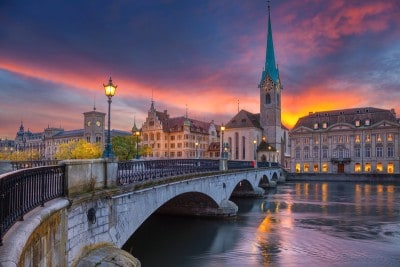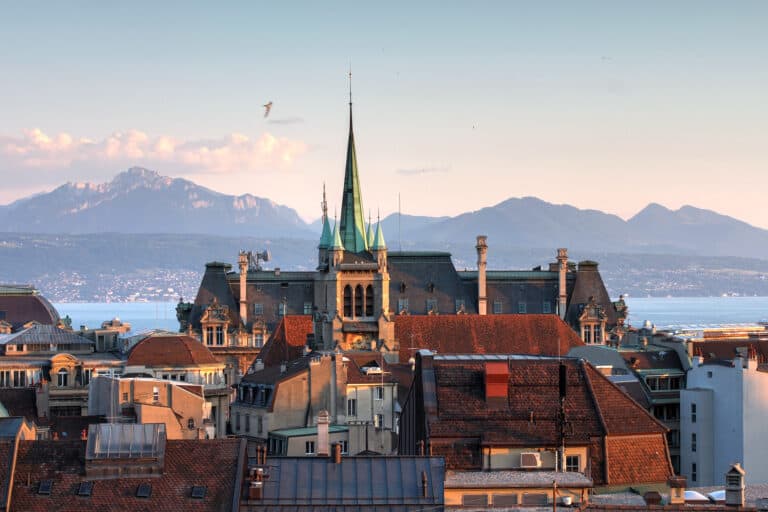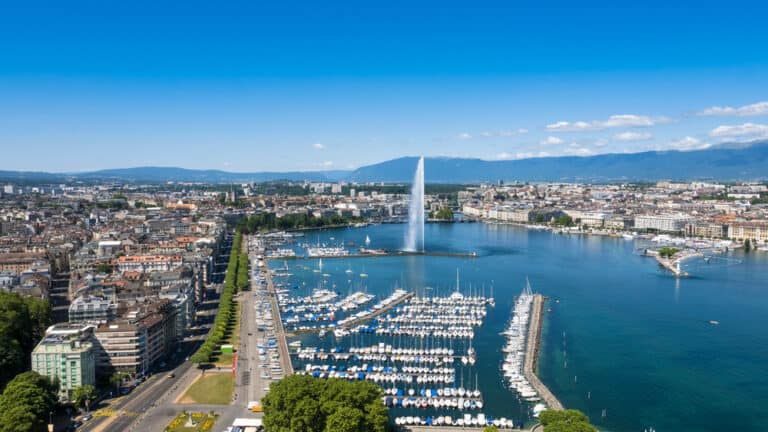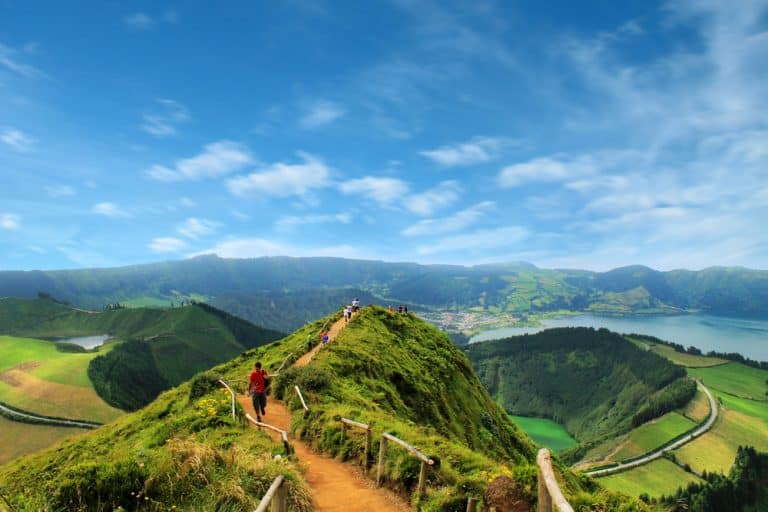One day in Bratislava: what to put on your itinerary

Bratislava, the capital of Slovakia, is a perfect destination for a one-day trip. Located on the banks of the Danube river, this historically important city is relatively small, and most of the main attractions are located in and around its picturesque old town.
The fact that Bratislava is just over 50 km from Vienna means you could, if you wanted to, combine a trip to both cities very easily and spend one day in Bratislava as well. Alternatively, you could drive to Bratislava in a few hours from several cities with international airports, such as Brno in the Czech Republic and Budapest in Hungary.
This post gives you an itinerary for one day in Bratislava that includes the best things to do in the city.
This post contains affiliate links
About Bratislava
– Bratislava is often referred to as one of Europe’s youngest capitals. Although the city has a long history, Slovakia has only been an independent country since 1993. At this point, the two countries that made up Czechoslovakia – the Czech Republic and Slovakia – separated.
– Located in central Europe, Bratislava is one of a handful of major European cities, including Belgrade, Budapest, and Vienna, that sits on the banks of the River Danube, Europe’s second longest river. This makes it an ideal place to take river cruises when operators run services during the tourist season.
– Bratislava is said to be the only capital city with direct borders with two other countries – Austria and Hungary.
– Bratislava has around half a million inhabitants, which is not big for a capital city. The country’s total population also only numbers around 5.5 million.
– The old town covers only a small geographical area, which sits in the shadow of Bratislava Castle, and therefore is very walkable.
How to get to Bratislava
By air
The easiest way to travel to Bratislava by air is to fly into nearby Vienna International Airport and then pick up a bus that stops outside arrivals. This regular service, operated by several companies (Slovak Lines, FlixBus, RegioJet), will drop you in central Bratislava in under an hour.
The best stop for the old town is Most SNP (the bus terminal under the SNP UFO bridge and near the cathedral). This is just a few minutes’ walk to the old town.
The main bus station (Bratislava Nivy or AS Nivy) where services terminate is not recommended as it’s to the east of the old town and a fair walk to the tourist sights. Unless, that is, your hotel is located close by. If that is the case, you might be interested to know that the bus station is part of a large complex with a shopping centre.
Bratislava does have its own international airport (M.R. Stefanik Airport). This is serviced by a number of budget airlines, so you might choose this option if you’re looking to save money. Bus 61 from the airport stops at the main train station (Bratislava Hlavná Stanica). From here you can pick up tram 1 and get off at the Centrum stop or take the number 93 bus.
You can also book an airport pick-up if you prefer.
By train
Alternatively, you could travel by train for your Bratislava day trip.
A popular short break is to spend a few days in nearby Vienna and just visit Bratislava by train for the day. As it’s only 50 km away, it’s a perfect place for a day out. Regular trains run between the Austrian and Slovakian capitals.
Bratislava’s main train station is to the north of the old town and about a 20 minute walk in. If you don’t want to do that, you can take tram 1 to the Centrum stop or alternatively bus 93.
If you fancy getting the train from Budapest to Slovakia, it’s worth noting that the train journey takes an average of just over three hours (although there are some that are a bit quicker). This is therefore more of an option if you’re staying for longer as the journey time wouldn’t end up giving you much time to sightsee.
Travellers that choose to come from Brno in the Czech Republic will find that the journey time is much shorter than from Budapest – between one and a half hours and two hours and 15 minutes. So this might be more feasible for a day trip.
You may also fancy travelling to Bratislava from other Slovak cities. To find out more, visit this site.
By boat
If you fancy a different type of travel experience, you might want to consider travelling by boat.
The Twin City Liner docks by the Most SNP bridge near the old town. In Vienna, the dock is only a 10-minute walk from St Stephen’s Cathedral in the centre of the city.
The sailing time is between 75 and 90 minutes. However, it’s really important that you check when services are running as the frequency and times of departures vary by season.
On certain days, you can also book a boat tour from Vienna which gives you four hours in the Slovak capital.

By car
Another option is to hire a rental car. You can do this from any number of airports within easy reach of Bratislava and visit for the day.
As well as Vienna, Graz in Austria, Brno and Prague in the Czech Republic, and Budapest in Hungary are a few hours’ drive away.
How to get around Bratislava
With its sole surviving medieval fortification, Michael’s Gate, the old town is home to some important historic buildings and monuments. Many are within easy walking distance of each other.
In addition to its cultural attractions, there are quite a few old narrow streets to explore in this central area and some traditional Slovakian restaurants. The old town is where you should focus your time if you choose only one day in Bratislava.
As Bratislava old town is tiny, the best way to explore it is on foot.
This map will help you plan your trip. It also gives you more details on where the top attractions are scattered centrally.
If you would like to join an organised walking tour, there are several options. This 2 hour tour takes you past the main sights in the city. It also includes entrance to Bratislava Castle.
Alternatively, if time is tight, you could book this tour which is just an hour.
You could also catch the small sightseeing bus that will take you to the main sights.
Or book onto this city tour that takes you around in a small motorised train.
One day in Bratislava: the top things to do
Here are the top things to do in Bratislava and what to put on your Bratislava itinerary.
Visit Bratislava Castle and learn about the country’s history
As you approach Bratislava, it’s impossible to miss the massive white, square-shaped and red roofed castle with its four distinctive towers perched on Castle Hill. This is perhaps the one landmark that best symbolises Bratislava. It dominates the city’s skyline and is stunning when lit up at night.

Overlooking the old town on top of a hill, and with fabulous views from the battlements outside the front main entrance – you can see neighbouring Austria and Hungary – Bratislava Castle should be at the top of your list of places to visit on one day in Bratislava. A former royal residence, the castle has undergone major renovations over the centuries, including after it burnt down in the early 1800s.
You can walk up to the castle from the old town in about 20 to 25 minutes, but note that the final stage is relatively steep. However it’s definitely worth the effort if you can do it.
In addition to its extensive grounds, you can pay an entry fee to go inside. The interior is lovely and houses the Slovak National Museum. This contains more than 250,000 artefacts reflecting the nation’s history and the history of Bratislava.
You could easily spend an entire morning exploring inside and around the grounds. For those with a good head for heights, you can ascend steep stairs up to the top of the Crown Tower. This is the oldest part of the building (dating back to the 13th century), and the top of the tower has some amazing views in all directions. There is also an attractive Baroque style garden behind the castle.
Once you have finished exploring, there is an excellent eatery called Hradna within the grounds. You can sit out in the summer on the terrace and look out over the old town and beyond. We had a great lunch here.
As you leave the castle, take a quick look at the Slovakian parliament building – look out for the massive Slovakian flag hoisted up on the flag pole.
Go to St. Martin’s Cathedral
Aside from Bratislava Castle, St. Martin’s Cathedral is perhaps one of the main sights to see in the city. If you’ve caught the bus to Bratislava and got off at the Most SNP bridge stop, you’ll pass this notable landmark as you enter the old town.

This lovely gothic cathedral dates back to the 1400s and is topped off with a coronation crown (look closely to see this as it’s easy to miss). This denotes the fact that the Hungarians crowned many of their kings here.
Once you step inside the cathedral, you’ll see its beautiful interior. It has three naves, and the vaulting is really impressive. From April to mid-November, tourists can also pay a small fee to visit the Treasury, which contains some lovely religious artefacts.
Wander around Michael’s Gate
During medieval times, Bratislava’s geographical position in central Europe led the city’s leaders to build an extensive fortification around the old town to protect its inhabitants. Sadly, very little of this fortification remains, and of the four original gates, Michael’s Gate is the only one that has survived.
With Bratislava Castle and St Martin’s Cathedral, this is arguably one of the top attractions to see if you spend only one day in Bratislava.
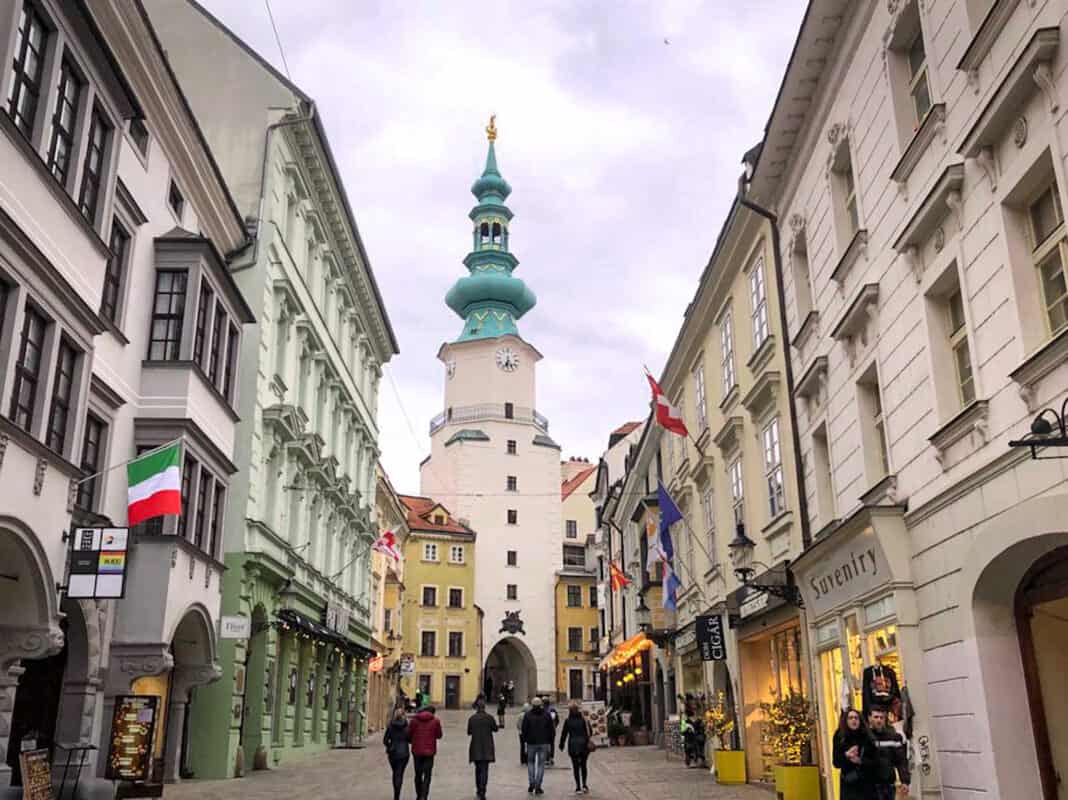
If you are entering the old town from the north, you’ll walk through this magnificent 14th-century structure that towers over 50 metres over the other buildings. Make sure you look down at the ground as you do this – you’ll see the “zero kilometre” plate, which gives you the distances of other capital cities from Bratislava.
The street leading up to the gate is also lovely, with some great bars and restaurants lining it.
Head to the main square with the Old Town Hall
One of the focal points for Bratislava’s Christmas markets, the main square (Hlavne Namestie), is framed by some attractive historical buildings, most notably the Old Town Hall.
The Old Town Hall is a significant political building and also holds Bratislava City Museum. Although we didn’t do it when we went in March, it is possible to climb the stairs that take you up to the top of the building’s tower. This goes to a height of 45 metres and gives excellent views of some of the city’s main sights.

The square also has an attractive fountain, and is a perfect spot to sit and watch the world go by. In the warmer months bars, cafes, and eateries put out tables and chairs.
This includes the Schokocafe Maximilian Delikateso, which has a great vantage point looking out onto the square.
Go into the Primate’s Palace and see the Hall of Mirrors
If you walk across the main square and through the arch to the right of the Old Town Hall’s tower, you’ll go into a small courtyard. Walk through this and out the entrance on the other side, and you’ll enter another beautiful square.

Here you will find a charming pink coloured building, the Primate’s Palace.

Built in the classicist style in the 1700s, this attractive palace has an intriguing history. Not far from Bratislava (in the east of modern day Czech Republic), Napoleon beat a combined Austrian and Russian army at the Battle of Austerlitz in 1805. After this famous victory, Austrian and French representatives signed a peace treaty here.
You have to pay an entrance fee to go inside, but it is recommended. Alongside pictures of the country’s Hungarian rulers, there is a collection of tapestries, including some 17th century English tapestries.
The highlight, however, is undoubtedly the Hall of Mirrors, which apparently is the only room inside the Primate’s Palace where you can take photos. The spacious room is stunning, with its sparkling chandeliers hanging from the ceiling.
Walk to the Church of St. Elizabeth, aka the Blue Church
Also known as the Blue Church, St Elizabeth’s Church is actually a more recent construction than you might think.
Built in the early 1900s when Art Nouveau was the latest fashion, the church’s stunning blue façade looks dazzling in photos but is even more incredible up close. Even if you don’t get to go inside when you visit, the outside is really beautiful, and I’m glad we went to see it up close.
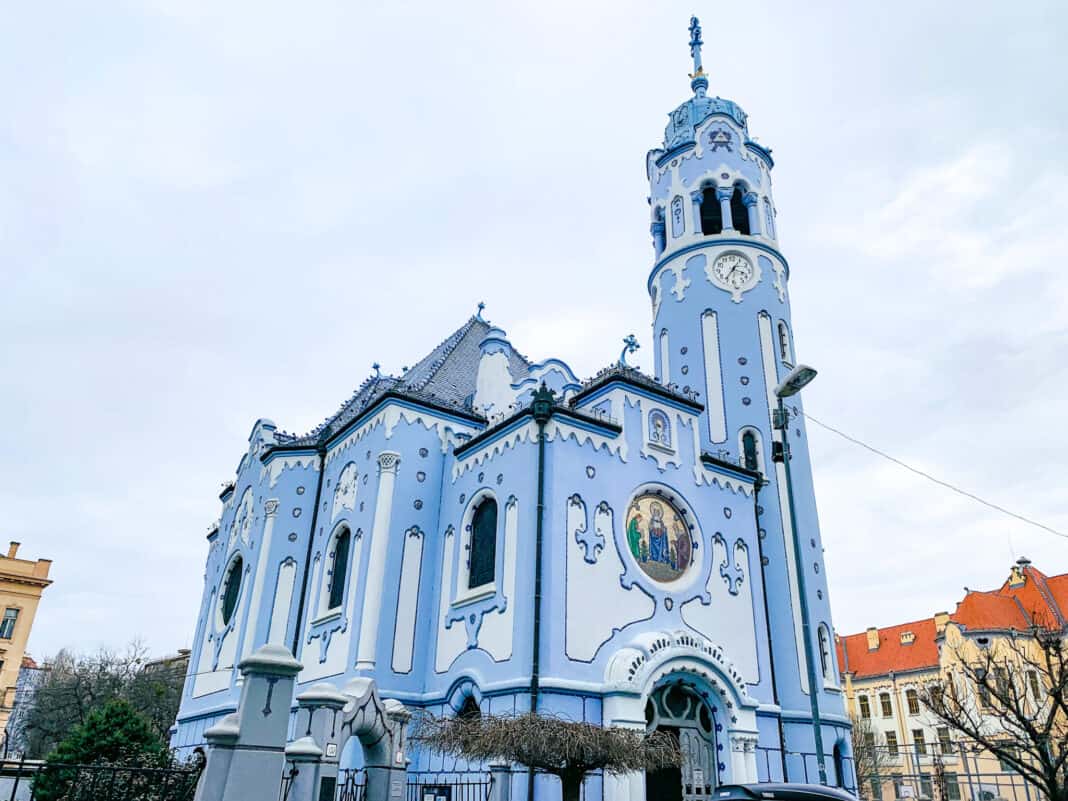
The church is a little bit out of the old town but not that far a walk, and it’s worth visiting. Also, there are a few other attractions close by should you want to visit them while you are in this part of the city: the SMN-Natural History Museum and the EUROVEA Waterfront. This has a promenade along the river, a shopping centre, and the new modern Slovak National Theatre.
See Slovakia’s White House
A short walk to the north of the old town, on the road that leads up to Bratislava’s main train station, you’ll find the attractive Grassalkovich Palace (the Presidential Palace).

Built in the Rocco style, the palace has an important place in Slovakian history and includes an extensive garden/park at the rear. More recently, the palace has served as the offices of the Slovakian President, who carries out official duties from this impressive building (for this reason, it’s apparently also known as the country’s ‘White House’).
You can’t normally go into the palace, but it’s worth seeing it from the outside as part of your walking tour.
Take in the views from the SNP bridge and UFO observation deck
When you arrive in Bratislava via the airport bus from Vienna International Airport, it is easy to miss the UFO observation deck – so named because of its shape – because your attention is drawn to the imposing Bratislava Castle dominating the skyline.

However, you pass under the UFO observation deck – attached to the south side of the SNP bridge by pylons as the bus nears the Most SNP bus terminal located under the north side of the bridge. This is near to St Martin’s Cathedral with the old town just beyond it.
A trip to the UFO tower is worth adding to your one day in Bratislava. It is one of the best places to visit for views across the city. There is a bar and restaurant here offering excellent panoramic views and an outside viewing platform.
I’m not good with heights, but it was absolutely fine on the deck. The views from 95 metres high are great; you see right out over the river and beyond. We went during the day, but I imagine a visit as dusk approaches would be quite magical. You can book a table in the restaurant and watch the sun go down as you eat and drink.
It’s very easy to get here. There is a pedestrian walkway that runs along both sides of the SNP bridge that takes you to the site.
If you are visiting during the day, you could also take advantage of being on the south side of the Danube and explore the City Park just to the east of the UFO bridge. If you walk down as far as the next bridge (Stary Most), you will be rewarded with fabulous photos of Bratislava’s skyline.
See the neo-renaissance Slovak National Theatre
Located in Hviezdoslavovo Square, the neo-renaissance Slovak National Theatre is another notable landmark. The late 19th-century building is beautiful, with a pedestrianised walkway leading up to it.

Only a short walk from the main square, it’s worth spending a little time exploring this area. There are some restaurants and bars, as well as shops close by, including the obligatory tourist outlets selling fridge magnets, t-shirts etc.
Spot the monuments and statues
As you wander around the city centre, you can play spot the statue! There are some interesting, unique, and sometimes quirky statues and monuments that are worth looking out for.
One of the most photographed is the small statue of a sewer worker sticking his head out of a manhole on the pavement. There is also another one outside one of the restaurants on the side of the main square.


There is also a historically important monument in front of a church. This is the Memorial to the Slovak National Uprising in 1944 when anti-Nazi Slovakian armed forces attempted to clear the country of its Nazi German occupation.
Far more dramatic is the (quite literally) monumental Slavin Memorial, located northwest of the city centre and standing over 50 metres high. It is quite a walk from the centre so you may not have enough time in just a day. As a result, we didn’t visit, but it is apparently the largest war memorial in central Europe.
It was erected by the Communist authorities after the Second World War to honour the thousands of Soviet soldiers who died ridding the city of Nazi German soldiers and their collaborators. The views over the old town and Bratislava Castle are apparently amazing.
Dine like a Slovakian
There are quite a few notable Slovakian restaurants in the old town worth checking out for a traditional meal. We were recommended Koliba Kamzik as a great place to go, and we weren’t disappointed. The restaurant is right by Michael’s Gate, and it is popular. It is therefore advisable to book a table for the evening.
In the old town, there are also quite a few traditional eateries, and I’d definitely recommend trying them out while you are here.
In terms of Slovakian specialties, you will find that Bryndzove pops up on the menu a lot. This sheep’s cheese is used in quite a few dishes and is yummy. Typically, the sheep’s cheese, made by following a special Slovak recipe, is served on potato dumplings and topped off with smoked bacon. This dish – Bryndzové halušky – is one of the country’s national dishes.
The cheese is also used in demikat soup, which sometimes comes with dumplings.
Other national dishes you may want to try while here include a cabbage soup called Kapustnica (vegetarians note that it also often has meat in it), a creamy fazula bean soup called Fazulova Polievka, and Slovak’s take on the Hungarian goulash – Segedin goulash.
If you have a sweet tooth, there are plenty of traditional desserts to try. Ryzovy Nakyp is a rice cake made with rice, milk, eggs, cream, and fruit, and served alongside fresh fruit. Zemlovka is a hearty bread pudding that also contains fruit. There’s also the sour cherry Visnova Strudla, a strudel dish that contains poppy seeds.
For cake, check out the historical patisserie Konditorei Kormuth on Sedlarska Street in the old town. This is a bit more expensive than other cafes you might find, but is worth a quick visit to see the wonderful interior and try out the cakes. We tried the Hungarian dobos and it was fantastic!

There is a good choice of bars and pubs in the old town too. We particularly enjoyed the cosy Antique American Bar, which has lots of character and is one to go to if you like cocktails.
Want to extend your trip?
If you would like to stay longer, there is much more to do in Bratislava than first meets the eye. In fact, there is a diverse range of different activities you can check out, some of which are covered below.
Devin Castle
Most tourists that travel to Bratislava for a short trip miss this castle ruin perched on top of a massive rock that hangs majestically over the River Danube and the River Morava. Although a trip out west to Devin Castle will take up pretty much half a day (it is around 10 km outside the city), it is definitely worth the effort if you have more time on your hands. It is an important archaeological site that dates back as far as the Neolithic Age.
Although the castle is outside the city, you can get there by public transportation. One way is the 29 bus, which leaves from the Most SNP (SNP bridge) bus terminal.
Alternatively, you could take a guided tour. This three-hour guided tour includes a hotel pick-up and entrance to the castle.
Covering six hectares, the castle remains are split into three sections which you can explore. Highlights include the Maiden Tower (otherwise known as the Nun), the beautiful nature surrounding the ruins, and the stunning panoramic views.
Wine tasting
Another activity to consider, especially if you want to see some of the surrounding countryside, is wine tasting.
Around an hour’s drive from the city is the Little Caparthians (or Small Carpathians) mountain area with a wine route along the vineyards. You could either head here independently or book a wine tour.
This tour takes you from your accommodation in Bratislava and out to the area. You stop off at a castle, visit the towns of Modra, Pizinok, and Svaty Jur, and then head to a vineyard for some wine tasting.
Other sightseeing tours
You can book a whole range of different sightseeing tours while on a visit to Bratislava. You can explore some of these here.
When to visit Bratislava
Due to its excellent transport connections and ease of getting to Bratislava, there really isn’t a best time to visit or a bad time.
However, accommodation costs will be higher in the spring and summer months. This partly reflects the fact that you’ll also be able to do more outside, for instance, if you fancy taking a cruise on the River Danube.
Average temperatures in July and August (the hottest months) can reach the mid to high 20s in celsius. By contrast, temperatures can dip into minus celsius figures from December to February.
Bratislava hosts a number of cultural events and festivals throughout the year. I’ve listed a few of these below in case this influences your decision on when to visit.
Also, like every major European city, Bratislava has its own annual Christmas markets with stalls in the Main Square and Hviezdoslavovo Square (where the old historic Slovak National Theatre is located).
Here are some notable events to put in your diary.
- Bratislava City Days: this is a city-wide festival that takes place over a weekend (in 2022 this was in April). Tourists can visit a number of attractions for free, and ride along the river for free.
- The Long Night of Museums and Galleries: on a Saturday in mid-May, museums and galleries have longer opening hours.
- The Cultural Summer and Castle Festival: from mid-June through to mid-September, the streets of the old town play host to creative arts, dance, and music performances, among other things.
- Bratislava Music Festival: this annual event starts in September, and visitors can listen to various music, including classical and jazz. The festivities also coincide with the Slovakian wine season so if you visit during this period, you can indulge in some new wines.
One day in Bratislava
I hope you have a great time on your day trip to Slovakia’s capital and enjoy exploring the main tourist attractions. If you have any questions, please feel free to get in touch.
Other ideas for short breaks in Europe
If you’re looking for ideas for other short breaks in Europe, check out my website. My recent posts include:


